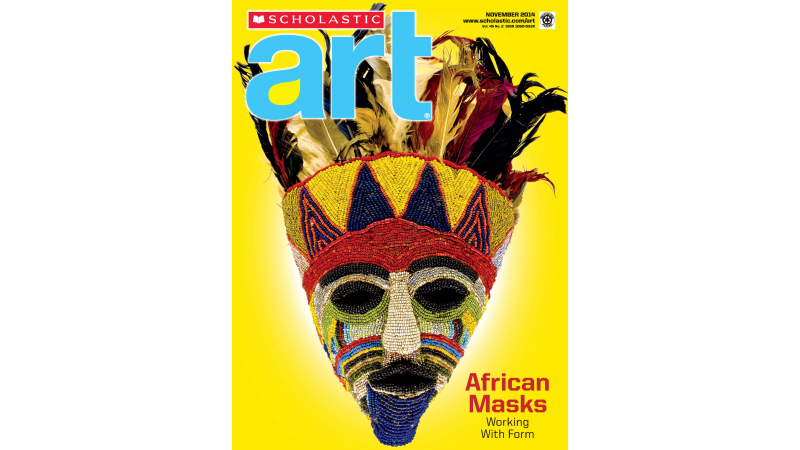 Today, Tara Welty, Editor-In-Chief for Instructor Magazine and Scholastic Art® Magazine has stopped by to share five ways to incorporate the arts into your classroom.
Today, Tara Welty, Editor-In-Chief for Instructor Magazine and Scholastic Art® Magazine has stopped by to share five ways to incorporate the arts into your classroom.
Last year, I met an incredible 13-year old named Boris Cochajil. Boris participates in Job Training in the Arts, an arts and character education program run by Downtown Aurora Visual Arts (DAVA) in Colorado. Boris told me that middle schoolers like him aren’t the cranky monsters people sometimes make them out to be; they’re just misunderstood. “Sometimes school feels like prison. They’re always commanding you,” he said. “We don’t want to be commanded. We want to express ourselves, how we feel actually.” Through DAVA, Boris found his expression. “Sometimes you might know a shy kid but when he finally gets a paintbrush, he’s painting like Picasso,” he said.
Boris makes an excellent case for art education and there is some compelling data to back him up. According to a 2012 study by the National Endowment for the Arts:
- 8th graders who were highly engaged in the arts in elementary school scored higher in science and reading than students with less exposure to the arts
- At-risk 8th graders with a history of engagement with the arts reported reading the newspaper at least once per week—more than those with lower engagement
- At-risk 8th graders who took part in art classes were more likely to earn a bachelor’s degree than similar students with limited exposure to the arts
Even if you’re not an art teacher, there are plenty of opportunities for arts integration in your classroom. Here are five favorites I’ve come across as editor of both Instructor and Scholastic Art magazines:
1. Create Living Tableaus
Libby Gray Brien, a principal intern and former teacher from Noel Community Arts School in Denver recommends drawing on theater to reinforce tricky concepts. She has students freeze in place to depict a scene from a story, represent a moment in history, or illustrate a scientific idea. Brien’s school participates in Turnaround Arts, a public-private program developed by the Presidents Council on the Arts and Humanities (PCAH) to bring art education to underserved schools and this technique is a favorite in the program. To learn more about Turnaround Arts, read this Instructor article.
2. Incorporate Visual Thinking Strategies
“Before starting a new social studies or language arts unit, introduce a piece of artwork related to unit theme, then have students silently observe for one minute, then describe what they see,” suggests Alicia Robinson, a music teacher and arts team leader at Roosevelt School in Bridgeport, Connecticut (also a Turnaround Arts school). Robinson says it doesn’t matter if students’ initial analysis is correct. As they engage visually, students are developing critical thinking and visual analysis skills.
3. Move Through Math
Use movement to physicalize math concepts, says Jan Adams of Winston-Salem/Forsyth County Schools in North Carolina. For example, Matrix Choreography: A forward step adds 10, a backward step subtracts 10. A step to the right adds 1, and a step to the left takes one away. Simple addition and subtraction problems translate into a series of dance steps. Then, Adams suggests, “make up a combination and figure out what number you would land on if your beginning point was 1—how about 14?” For more activities like this one, check out this Instructor article.
4. Go Full STEAM Ahead
Already doing STEM (science, technology, engineering, and math) projects in your classroom? Get more out of them by putting art into the mix. “When you think about the components of engineering something and creating art, many factors are the same,” says Christine Miller, a kindergarten teacher at Dranesville Elementary School in Herndon, Virginia. When Miller introduces the engineering-design process (ask, imagine, plan, create, improve) through the lens of creating art, students are less afraid to make mistakes (because they know mistakes in art can be erased). Learn more about STEAM here.
5. Incorporate Art History into Nonfiction Reading Lessons
Reading about art and artists’ lives brings history to life. When students learn the story of a work of art, a painting becomes much more than an artifact in a museum; it becomes a story that connects us to the past and links the desire to create and innovate through humanity. As you work to incorporate more nonfiction into your literacy lessons, I recommend Scholastic Art. But as the editor, I admit I’m biased. I encourage you to decide for yourself and check out a sample issue.
I hope you find these tips useful!



